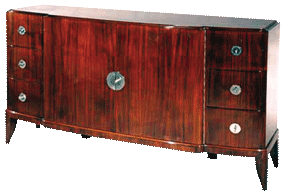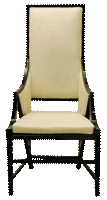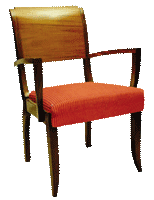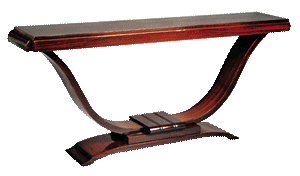- Ah, the heat
- Guest Editor’s Column
- Art Moderne: Art Deco Furniture
- Lithograph Tin Toys
- Film Memorabilia
- Creative Impulse
- Hard Talk
- Possibility of Democracy in China
- In the News
- Artist Index and Statistics
- Market Insight
- Auction Reports : What happened
- Auction Reports : what's forthcoming
- Art Bengaluru
- Art’s Eye-view
- The month that was
- Photo Feature
- Roerich bridges Indo-Russian Cultural Relations
- Image and Symbol: Painters' Perceptions
- Image and Symbol: Sculptors' Perceptions
- My Window Shut to Open
- Paramjit Singh
- Mrinalini Mukherjee
- The Spirit of A Butterfly
- Have I Ever Opposed You?
- S(outh) E(ast) A(sia)
- Splitting the Other
- The Things That Happen When Falling in Love
- Millijunction
- Terminology
- Know your Act
- Different hues of Aakriti
ART news & views
Art Moderne: Art Deco Furniture
Volume: 2 Issue No: 3 Month: 4 Year: 2010

The Art Deco style, which was popular from 1925 until 1939, derived its name from a design exhibition held in Paris in 1925. The term 'Art Deco' is of recent coinage, and is a contraction of the full title of the celebrated 1925 Exposition International des Arts Decorattifs et Industriels Modernes, at which the style was extravagantly displayed. Art Deco was first seen in the work of French designers who had been developing and refining a post-World War I machined-looking style in reaction to Art Nouveau's fluid, sinuous motifs and emphasis on individual craftsman-made pieces. The streamlined designs of ocean liners and industrial machinery wielded a key influence on the clean-lined, sleek geometry of Art Deco forms and patterns as did the Tutankhamen Exhibition, held in Paris in 1922.
 By the mid -1920s the 'pure' or 'high' Art Deco style had reached maturity. Its first tenet, that form must follow function, later remained unchallenged by all succeeding twentieth-century schools of design, but its second, related to decoration, proved its undoing. Ironically, it was the art deco proponent himself who had recoiled against the superfluous ornamentation, claiming that, all excess ornamentation performed no practical function whatever and must therefore go. Decoration, it was reasoned, must be contained within the piece's fundamental shape. Therefore marquetry, carved and cast bas reliefs and contrasting parquetry panels were permitted, all, of course, in the best materials that money could buy.
By the mid -1920s the 'pure' or 'high' Art Deco style had reached maturity. Its first tenet, that form must follow function, later remained unchallenged by all succeeding twentieth-century schools of design, but its second, related to decoration, proved its undoing. Ironically, it was the art deco proponent himself who had recoiled against the superfluous ornamentation, claiming that, all excess ornamentation performed no practical function whatever and must therefore go. Decoration, it was reasoned, must be contained within the piece's fundamental shape. Therefore marquetry, carved and cast bas reliefs and contrasting parquetry panels were permitted, all, of course, in the best materials that money could buy.  Decoration remained an integral part of Art Deco furniture and its proponents argued that beauty in the home was essential to people's psychological well being. Paul Follot, a strict traditionalist and art deco adherent, defended this stance in a speech: 'We know that the “necessary” alone is not sufficient for man and that superfluous is indispensable for him …or otherwise let us also suppress music, flowers, perfumes… and smiles of ladies!'
Decoration remained an integral part of Art Deco furniture and its proponents argued that beauty in the home was essential to people's psychological well being. Paul Follot, a strict traditionalist and art deco adherent, defended this stance in a speech: 'We know that the “necessary” alone is not sufficient for man and that superfluous is indispensable for him …or otherwise let us also suppress music, flowers, perfumes… and smiles of ladies!'  Opposition to the idea of superfluous decoration began by the early 1920's, Le Corbusier speaking against Rhulmann's remark that 'if only the very richest can afford to pay the price of innovation, they are also the only ones with the power to sponsor it'. The future of furniture (or anything else) did not rest with the rich, and even less with their decorative preferences. An object's greatest beauty lay, rather, in its perfect adaption to its usage. To reduce furniture to its basic elements was not a regression, but a rebirth of everything espoused by the art deco designers. By 1926 the band modernists including Le Corbusier outspoken in their criticism of art deco furniture designers who still catered only to select clients and produced only pieces uniques or limited editions. They argued that the new age required nothing less than excellent design for everyone and that quality and mass-production were not mutually exclusive. For furniture in the late 1920s and 1930s, this aim could be realized through the use of metal and glass.
Opposition to the idea of superfluous decoration began by the early 1920's, Le Corbusier speaking against Rhulmann's remark that 'if only the very richest can afford to pay the price of innovation, they are also the only ones with the power to sponsor it'. The future of furniture (or anything else) did not rest with the rich, and even less with their decorative preferences. An object's greatest beauty lay, rather, in its perfect adaption to its usage. To reduce furniture to its basic elements was not a regression, but a rebirth of everything espoused by the art deco designers. By 1926 the band modernists including Le Corbusier outspoken in their criticism of art deco furniture designers who still catered only to select clients and produced only pieces uniques or limited editions. They argued that the new age required nothing less than excellent design for everyone and that quality and mass-production were not mutually exclusive. For furniture in the late 1920s and 1930s, this aim could be realized through the use of metal and glass.  The characteristics of art deco furniture are sleek, smooth, streamlined lines, geometrical patterns, and experimental use of industrial materials such as metals, plastics, and glass. Art deco furniture is modern and functional. Art deco design is recognizable because of three main things: distinct geometric shapes, intense, bright colors that stand out, and a decorative look. "Art Deco is characterized by a linear, hard edge or angular composition, often with a vertical emphasis, and highlighted with stylized decoration". Also, Art Deco, while being decorative, is very simple, in that it doesn't have any complicated shapes. The Art Deco movement is also characterized by clean lines, streamlining, and symmetry. In addition, Art Deco works exhibit abstraction, distortion, and simplification, particularly geometric shapes and highly intense colors.
The characteristics of art deco furniture are sleek, smooth, streamlined lines, geometrical patterns, and experimental use of industrial materials such as metals, plastics, and glass. Art deco furniture is modern and functional. Art deco design is recognizable because of three main things: distinct geometric shapes, intense, bright colors that stand out, and a decorative look. "Art Deco is characterized by a linear, hard edge or angular composition, often with a vertical emphasis, and highlighted with stylized decoration". Also, Art Deco, while being decorative, is very simple, in that it doesn't have any complicated shapes. The Art Deco movement is also characterized by clean lines, streamlining, and symmetry. In addition, Art Deco works exhibit abstraction, distortion, and simplification, particularly geometric shapes and highly intense colors. The Art Deco style was influenced by a number of other art movements. Some art movements that had a major influence on Art Deco were:
- Cubism - the reduction of natural forms to their geometrical equivalents.
- Expressionism - forms derived from nature are distorted or exaggerated and colors are intensified for emotive or expressive purposes.
- Futurism - forms derived chiefly from Cubism were used to represent rapid movements and dynamic motion; showing hostility to traditional forms of expression.
- Vorticism - using the concept of a vortex.
 Wood used by art deco furniture makers were very often of the exotic kind such as ebony, frequently used as a veneer, and also much use was made of the technique of lacquering. Snakeskin, parchment, and sharkskin were sometimes used for decorative effect. Art deco French furniture was sometimes made of chrome plated steel and forged iron, deliberately modern materials. One consequence of this use of rare or unusual construction methods and materials was that Art Deco furniture of this era was generally very expensive.
Wood used by art deco furniture makers were very often of the exotic kind such as ebony, frequently used as a veneer, and also much use was made of the technique of lacquering. Snakeskin, parchment, and sharkskin were sometimes used for decorative effect. Art deco French furniture was sometimes made of chrome plated steel and forged iron, deliberately modern materials. One consequence of this use of rare or unusual construction methods and materials was that Art Deco furniture of this era was generally very expensive.
As the movement developed over time, and exported itself to other countries, for example in American Art Deco furniture, it was refined and normalized to the point where it became a hugely popular style of furniture. The movement attempted to provide a comprehensive system of design, for architecture, jewelry, sculpture, and interiors. According to Bevis Hillier "Art Deco's ultimate aim was to end the old conflict between art and industry, the old snobbish distinction between artist and artisan, partly by making artists adept at crafts, but still more by adapting design to the requirements of mass-production."